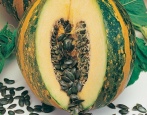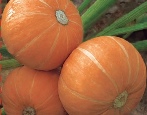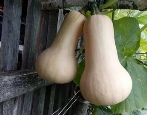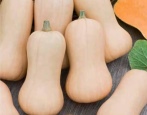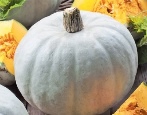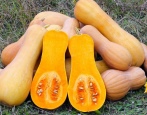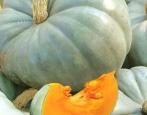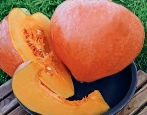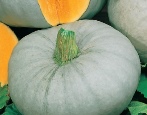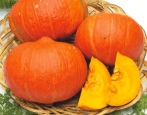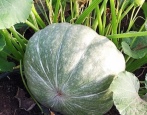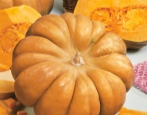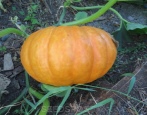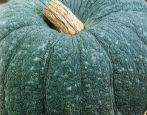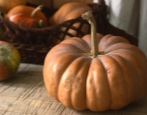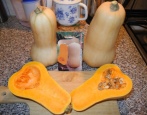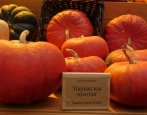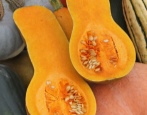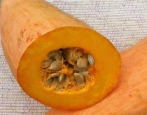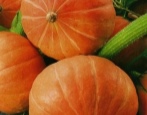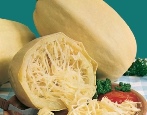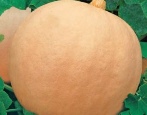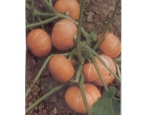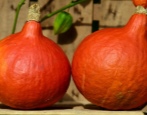
- Authors: Gavrish S.F., Portyankin A.E., Shamshina A.V., Shevkunov V.N., Khomchenko N.N., Surovova T.Ya., Pluzhnik I.S., Bychik A.S., Chaikin NS.
- Year of approval: 2015
- Growth type: powerful
- Leaf color: green with white spot
- The form: rounded-flattened
- Weight, kg: 3-4
- Coloration: brown to dark brown, with slight marbling and waxy bloom
- Bark: thin, leathery
- Color of the pulp: bright yellow
- Pulp (consistency): dense, crispy, juicy
Honey pumpkins are known to many healthy food lovers. Vegetables have many beneficial properties. And also culture is appreciated for its taste. Pumpkin Honey Fairy Tale has a high yield, easy care and excellent appearance.
Breeding history
Pumpkin Honey Fairy Tale is a relatively young variety. Was approved for use in 2015. A team of authors headed by the breeder Gavrish S.F.
Description of the variety
In addition to the Honey Fairy Tale variety, the originators also produce other honey varieties:
Dessert;
Orange;
Gorgeous;
Princess;
Guitar.
They all have different shapes and characteristics, but are relatively identical in taste.
The culture belongs to the nutmeg species. The advantage of the Honey Tale pumpkin is that the crop has good yields and excellent taste. Unpretentiousness in growing, resistance to temperature extremes, as well as to short frosts is noted. Due to the external data, as well as the density of the peel, the pumpkin can be transported over long distances without losing its appearance.
Among the minuses, it is noted that the culture loves shading, direct sunlight burns the foliage and creates unfavorable conditions. The pumpkin does not tolerate transplanting, therefore it is recommended to grow seedlings in peat pots.
Characteristics of the appearance of plants and fruits
Climbing bush, growth rate is fast and powerful. The length of the shoots can reach 2.5 m. The size of the leaves is large, they are slightly wrinkled and fleecy. Their color is green, with a slight white spot.
Fruits are medium-sized, round-flattened in shape. The mass of one vegetable is 3-4 kg. There are also more weighty specimens, provided that the inflorescences are partially removed, reducing thickening.
Skin color is brown or dark brown. Sometimes there is a slight marble and waxy coating. Segmentation is present. The bark is thin and leathery.
The pulp is dense, crispy and very juicy, it is bright yellow in color. The seed nest is small, inside it are loose planets. The seed content is average, they are cream in color.
The keeping quality of the fruits is good, on average from 100 to 120 days.
Purpose and taste
Pumpkin Honey Tale has a universal purpose, so it can be used to prepare various dishes (mashed potatoes, soups), as well as used in cooking for making cakes, sweets or jams.
The fruit has a sweet taste. There is a strong honey aroma. In addition to vitamins, the vegetable contains a high percentage of carotene.
Ripening terms
The culture is mid-season. The growing season takes 110 to 115 days. Harvesting takes place in July-September, and may be slightly extended.
Yield
The pumpkin has good yield indicators, from 1 m2 an average of 2.1 to 2.5 kg is removed.
Growing regions
Recommended growing regions are:
northern;
Ural;
Northwestern;
TsCHO;
Volgo-Vyatsky;
North Caucasian;
Middle Volga;
Nizhnevolzhsky;
West Siberian;
East Siberian.
Growing and care
Any crop cultivation begins with the right choice of seeds. Better to choose fresh pumpkin seedlings. Many growers claim that seeds are stored for several years, but the older the harvest, the less effective germination.
Having selected the necessary seed, you can start sowing. The soil is preliminarily cultivated. It can be calcined in the oven or treated with a solution of potassium permanganate. The seeds are also treated with this disinfection solution.
Sowing is carried out in April, and planting of seedlings in open ground - in May-June.
The selected area needs to be processed. The earth is dug up, bringing in useful minerals. It is worth noting that the honey fairy tale pumpkin does not like clay soil. Therefore, it is best to use sand and peat to dilute the soil. The landing pattern should be 100x50 cm.
Since any pumpkin varieties do not like transplanting, you can plant seedlings in the holes together with a peat pot. Before buying, you must also look at the composition of the container - there should be about 65-75% of peat, if this indicator is less, then the pot will not dissolve, which means it will not allow the roots to grow properly.
Subsequent irrigation of the crop is carried out in accordance with the established regime. Its active phase occurs before the main flowering. Then it becomes a little less frequent, and then, after the formation of the fruits, it resumes as usual. This procedure is generally coordinated with the weather conditions, depending on the dryness of the summer.
As a top dressing, you can use a solution of mullein or bird droppings. Mineral complexes are used only if the culture really needs it: its growth slowed down, the leaves began to turn yellow or curl. And fertilizers in this case are applied only after the pumpkin has been examined for the presence of disease or pests.
